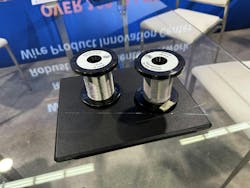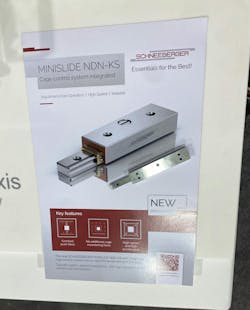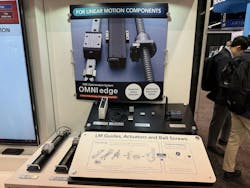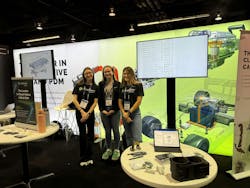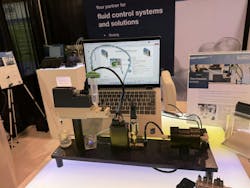Around every corner at MD&M West was another innovative product, service or solution. There was so much to see at this year’s event to help medical device manufacturers get and stay ahead of this rapidly evolving industry. Machine Design brings you six more standouts as the event comes to a close.
Specialty Metal Processing
Ulbrich Specialty Wire Products showcased its role as a re-processor of metals, focusing on the production of specialty strips from stainless steel, nickel and titanium-based alloys. Patrick Meinert told Machine Design about the company’s capability to roll strip materials to tighter tolerances, providing mechanical properties that are not widely available in high volumes.
They focus on producing complex shapes, offering near-net shapes instead of traditional rectangles that require further machining. This includes ultra-fine, round and flat wires catering to medical applications, such as stranded products suitable for advanced catheter systems.
READ MORE: A Showcase of Innovations Turns Heads at MD&M West
The company also produces straight and cut-to-length flat wire for niche applications. The products are manufactured at Ulbrich’s South Carolina facility, ensuring adherence to medical-grade requirements using biocompatible materials, including 304 and 316L stainless steel, and maintaining a contaminant-free processing environment.
A Miniature Automation Solution
Schneeberger Inc. introduced a new addition to its product lineup, focusing on automation with its latest miniature slide. The company, known for serving original equipment manufacturers across a range of industries—including machine tool, solar technology, semiconductor technology, electrical engineering and medical engineering—highlighted this compact version of its existing products.
The miniature NDN slide is designed for high-speed operation and high acceleration, making it especially suitable for applications in medical engineering. Its small size and versatility allow for use in various fields, including optics and photonics. The product can be manufactured from stainless steel and offered with different types of coatings, enhancing its adaptability to specific applications.
While the miniature slide is particularly useful in medical contexts due to its size, it can also be utilized across various industries depending on the machinery size and precision requirements, a company representative told Machine Design.
Streamlined Linear Motion Technology
THK America Inc. displayed its approach to linear motion technology. Their exhibit highlighted the integration of multiple components into a single, streamlined unit, particularly focusing on actuators that simplify both the design and construction of various systems, Bryan Alarcon told Machine Design.
THK’s actuators combine essential elements like linear motion guides, drive systems (such as ball screws or belts), and base frames into one cohesive part, for efficiency and reducing complexity for manufacturers.
Contamination Prevention for Medical Device Manufacturing
Porex highlighted their solutions in the diagnostics, medtech and bio-processing markets, emphasizing the importance of contamination prevention for engineers involved in medical device manufacturing. Subho Goswami told Machine Design that their collaboration with Cirrus demonstrates how Porex filters effectively remove unused active pharmaceutical ingredients (APIs) from donor blood, ensuring safety and efficacy.
READ MORE: As Seen at MD&M West 2025: Product Showcases, Solutions and More
Additionally, Porex filters prevent clumping in inhalers and possess antibacterial properties— crucial for delivering uncontaminated medication. In dialysis applications, Goswami said their filtration solutions eliminate contaminants during bicarbonate reconstitution, maintaining the purity of fluids.
Porex is also advancing technologies that convert whole blood into universal donor blood by removing antigens, thereby enhancing transfusion compatibility. In medical imaging, their vents play a key role in ensuring the uniform delivery of contrast agents during mammograms, preventing air and contaminants from affecting diagnostic outcomes.
Advanced Integrated CAM Capabilties
PTC’s Onshape unveiled its latest innovation at MD&M West: CAM Studio, an embedded computer-aided manufacturing (CAM) offering that is now native to the Onshape platform. Brenna Robillard told Machine Design this development aims to enhance the capabilities of users by integrating CAM functionalities directly within the design environment.
Additionally, the company is gearing up for the launch of its Onshape Government, which will provide teams with an ITAR (International Traffic in Arms Regulations)-compliant environment, ensuring secure and regulated operations for government-related projects. The cloud-native CAD and PDM package aims to enable secure, real-time collaboration and supports work from nearly any device anywhere.
Closed-loop Dosing System
Burkert’s Craig Occhiato gave Machine Design a demo of the company’s closed-loop dosing system that achieves remarkable precision, capable of dispensing half a microliter per stroke. This cutting-edge system is reported to be the smallest of its kind on the market and utilizes electronic controls along with a CAN bus to precisely manage air pressure over liquid.
READ MORE: The Shift from Digitization to Datafication in Manufacturing
By finely adjusting this air pressure and using a fast-responding valve, the system delivers doses accurately. The system is made to be compatible with various aggressive media found in medical devices, protecting both the fluid and the internal components. The integration of a pressure sensor provides real-time feedback, allowing for continuous adjustments that allow dosing precision compared to traditional open-loop systems, which require manual recalibration.
Burkert offers a demo kit that enables engineers to easily set up the system using components with CAN bus communication, all connected through a USB to a PC for straightforward testing and configuration. Overall, Occhiato explained this advanced dosing system has attracted attention from medical device engineers due to its non-contact dosing capabilities, real-time volume verification and operational efficiency.
Editor’s note: For more show coverage, be sure to check out our MD&M West 2025 content hub.
About the Author
Sharon Spielman
Technical Editor, Machine Design
As Machine Design’s technical editor, Sharon Spielman produces content for the brand’s focus audience—design and multidisciplinary engineers. Her beat includes 3D printing/CAD; mechanical and motion systems, with an emphasis on pneumatics and linear motion; automation; robotics; and CNC machining.
Spielman has more than three decades of experience as a writer and editor for a range of B2B brands, including those that cover machine design; electrical design and manufacturing; interconnection technology; food and beverage manufacturing; process heating and cooling; finishing; and package converting.
Email: [email protected]
LinkedIn: @sharonspielman
Facebook: Machine Design
YouTube: @MachineDesign-EBM

